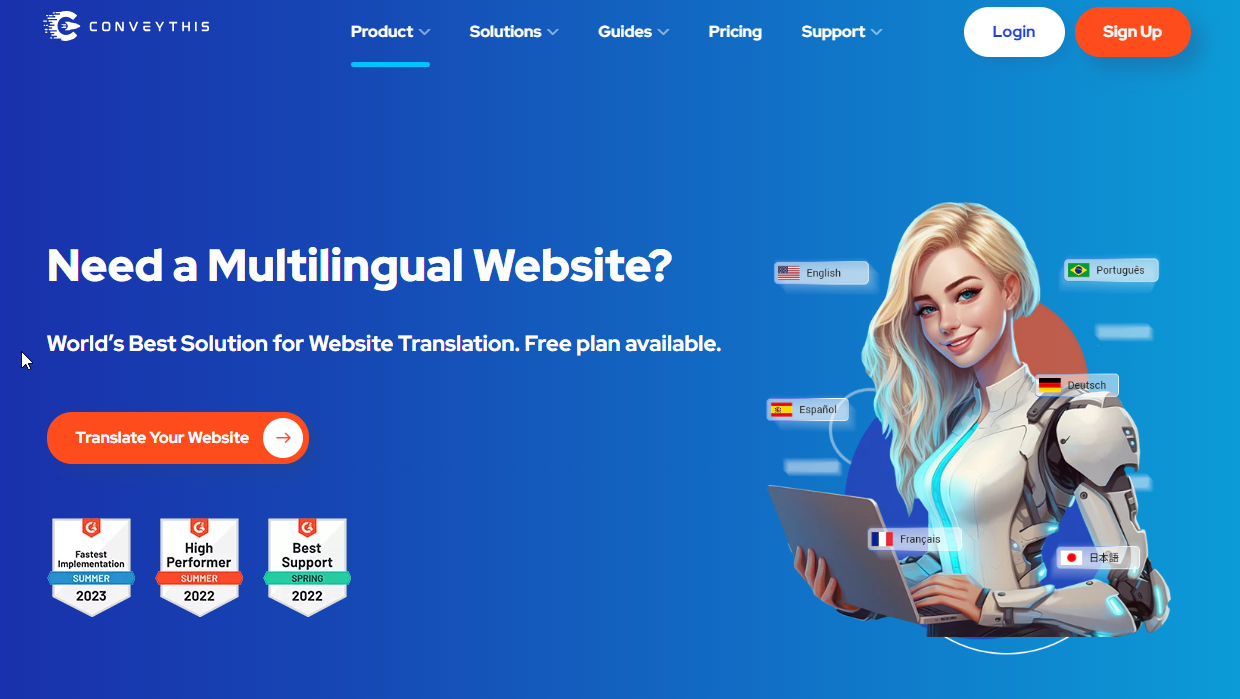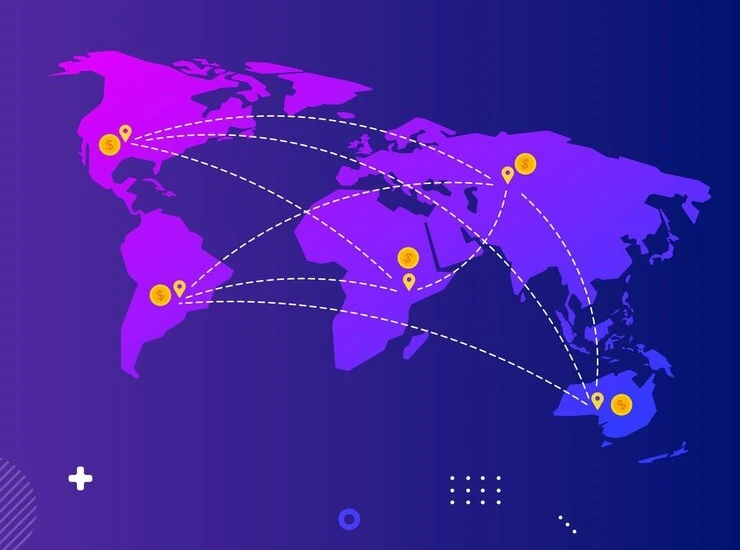Spanish: The Key to a Thriving E-commerce Success
Spanish: The Key to a Thriving E-commerce
Did you know that the U.S. is the second-largest Spanish-speaking country? This milestone was reached in 2015, when the number of Spanish speakers in the United States surpassed that of Spain, the birthplace of the language. Since then, the number of Spanish-speaking residents in the U.S. has continued to grow, positioning the country as the global leader in Spanish-speaking populations, with Mexico as the only nation that surpasses the U.S. in this regard. According to the Instituto Cervantes in Spain, over 50 million people in the U.S. speak Spanish, making it a key demographic that no business should overlook. The growing Hispanic population represents a powerful force in shaping the cultural and economic landscape of the nation with.
When we also consider that U.S. ecommerce accounted for over 11% of total retail sales last year[5] and is a $500 billion market[6], it becomes clear that embracing the U.S. Hispanic community presents a massive opportunity for growth. These consumers, many of whom prefer to shop in Spanish, represent a huge untapped potential for businesses that are willing to meet them where they are—on ecommerce platforms. Ignoring this demographic is not just a missed opportunity; it’s a significant disadvantage in an increasingly competitive market. Catering to their language preferences, especially in the digital space, is a surefire way to build loyalty and increase sales.

However, despite the obvious market opportunity, there is a glaring gap. Only 2.45% of U.S. ecommerce websites are multilingual, meaning that over 95% of U.S.-based ecommerce sites are available only in English. This presents a significant opportunity for businesses willing to embrace bilingualism, as the competition for the Spanish-speaking audience is still relatively limited. Within the small percentage of multilingual sites, fewer than a fifth offer Spanish versions, leaving a vast opening for brands to cater to this large and growing population.
This gap in the market highlights the fact that only a select group of forward-thinking companies have recognized the potential of the Hispanic consumer base. These early adopters have positioned themselves as leaders in bilingual ecommerce, successfully reaching Spanish-speaking customers and reaping the benefits of this underserved market. By offering Spanish-language versions of their websites, these companies have gained a competitive edge, attracting a loyal and expanding customer base.
Now is the perfect time to capitalize on this opportunity. By offering a Spanish version of your ecommerce site, you can attract the 50 million native Spanish speakers in the U.S., as well as the many more who are bilingual. This will not only expand your market reach but also increase your sales, brand loyalty, and customer satisfaction in a way that few businesses have managed to do so far. The U.S. Spanish-speaking market is growing, and the potential for ecommerce businesses to tap into it has never been greater. Don’t let your competitors be the ones to capture this vast and valuable audience—start speaking their language today.
How to Become Un Sitio Bilingüe: Unlocking the Power of Multilingual Websites
The U.S. has historically lagged behind much of the world in creating and designing multilingual websites. English has long been prioritized over other languages, often at the expense of engaging vast and valuable consumer bases. This oversight represents a missed opportunity for financial growth, particularly given the diverse linguistic landscape of the country.
Businesses that limit themselves to English-only websites are leaving money on the table. The competition for English-speaking audiences in the U.S. is fierce, with countless e-commerce sites vying for attention. However, adding a Spanish version to your website can dramatically change the game. Spanish speakers represent a rapidly growing market segment in the United States, with a high demand for content tailored to their language preferences. By catering to this bilingual audience, businesses can gain a competitive edge and tap into an underserved yet powerful consumer demographic.
That said, engaging a bilingual user base isn’t as simple as pasting your website content into Google Translate and calling it a day. Automated translations often miss context, tone, and cultural nuances, leading to a poor user experience that can alienate potential customers. A successful bilingual strategy requires thoughtful planning, professional translation, and cultural adaptation to ensure that your message resonates equally well in both languages.
Fortunately, you’re in the right place to learn how to create a multilingual strategy that works. In this article, we’ll guide you through the steps of building a truly bilingual e-commerce site. But before diving into the “how,” let’s explore more compelling reasons why making your store available in Spanish is a smart move for your business.
Speak English in Public but Browse in Spanish: The Bilingual American Way
America’s native Spanish speakers have mastered the art of bilingualism. While they often communicate fluently in English at school, work, and other public settings, their private lives and personal habits frequently lean towards Spanish. This dual-language lifestyle reflects their deep connection to their cultural heritage and showcases how language can serve different roles depending on context.
A closer look at their digital preferences reveals some intriguing habits. Many Hispanic Americans set their devices—such as phones, tablets, and laptops—to Spanish, ensuring that everything from app interfaces to system commands aligns with their native language. Their keyboards often feature the iconic ñ, and even their AI assistants, like Alexa and Siri, deliver directions, reminders, and answers in Spanish. This preference highlights the importance of Spanish not only as a means of communication but also as an integral part of their identity.
Moreover, bilingual searchers exhibit a unique online behavior. According to Google, they use English and Spanish interchangeably, depending on the context of their searches or the type of content they’re looking for. Whether it’s reading news articles, shopping online, or watching videos, this dual-language approach positions bilinguals as a dynamic audience that accounts for over 30% of all online media consumption in the United States[7].
For businesses, this insight underscores the need to adopt a bilingual or multilingual approach to their digital presence. By offering content and interfaces in Spanish, companies can effectively engage this growing demographic and foster stronger connections with a culturally diverse and tech-savvy audience.
So How Is Spanish: The Key to a Thriving E-commerce?
1. Invest in Spanish-Language SEO
Here’s a key insight: search engines like Google know which language your browser and devices are set to, and they prioritize delivering search results in that language. For example, if your phone is set to English, you’re unlikely to see top search results leading to websites in French or Japanese. The same rule applies to Spanish speakers—their search results are tailored to sites in Spanish.
This means that having your website available in Spanish isn’t just a nice-to-have—it’s a competitive necessity. Spanish-language sites are given priority over English-only sites in searches conducted on devices set to Spanish. If you’re in the U.S. and don’t offer your site in Spanish, you’re at a disadvantage, surrounded by competitors who are already tapping into this underserved audience.
The good news? Spanish speakers represent an untapped consumer base, and the sooner you make your site bilingual, the greater the rewards will be. But creating a Spanish-language version of your site is just the first step. To truly maximize its impact, you need to optimize for Spanish-language SEO. Tools like ConveyThis can help ensure that search engines identify your site as a relevant, high-quality resource in Spanish.
Remember: even the most visually stunning Spanish version of your site won’t be effective if your target audience can’t find it. Spanish-language SEO ensures that your site appears in the right search results, connecting you with your new audience.
2. Decode Spanish-Language Metrics
Launching a Spanish version of your site is an important milestone, but tracking its performance is equally crucial. You need to analyze how well your Spanish content is engaging users and how these visitors are finding you online.
Google Analytics is an invaluable tool for gathering insights about your audience. It can show you which language version of your site visitors are using and how they arrived at your site—whether through search engines, backlinks, or direct navigation. Understanding these patterns enables you to make data-driven decisions and refine your strategy for even greater success.
To access these insights, navigate to the “Language” section under the “Geo” tab in Google Analytics. This will provide detailed data on your audience’s language preferences and behavior. You can also explore other features within Google Analytics, such as demographic data and traffic sources, to further optimize your bilingual strategy[8].
By staying informed about your Spanish-language metrics, you can identify what’s working and what needs adjustment. This helps you avoid relying on guesswork and instead base your decisions on concrete evidence of how your audience interacts with your content.
Creating Multicultural Content: Speaking to the Heart of Your Audience
Every language carries its culture, history, and nuances, and bilingual individuals grow up immersed in two of each—double the grammar, slang, traditions, and values. While some of these elements might seem contradictory, bilingual people find unique ways to reconcile them, turning their dual linguistic and cultural identity into a source of pride and comfort.
When creating multicultural content, understanding these complexities is crucial. Whether you’re delivering a public service announcement or crafting a marketing campaign, how you approach language and culture can make or break your message.
For public service campaigns, direct translations and consistent formatting often suffice. The goal is clear, straightforward communication. For instance, the City of New York launched an ad to combat predatory lending with nearly identical English and Spanish versions. Such campaigns thrive on clarity and universality.

Source: https://www1.nyc.gov/site/dca/media/combat-predatory-lending.page
Selling a Product: The Art of Adaptation
Marketing products to bilingual or Spanish-speaking audiences is far more nuanced. To connect with Hispanic American consumers effectively, businesses need to go beyond translation and embrace cultural adaptation. Here’s how:
Adapting Existing Campaigns:
- Visual Elements: Consider color palettes, imagery, and models that resonate culturally with your audience.
- Messaging: Slogans and taglines may need reworking to reflect values like family, tradition, or community, which are highly significant to Hispanic culture.
Creating Exclusive Campaigns:
A more impactful approach is to develop campaigns specifically tailored to Spanish-speaking audiences. For example, Payless ShoeSource achieved tremendous success by creating ads designed exclusively for Hispanic customers. These ads aired on channels popular with Spanish-speaking audiences, such as Spanish-language TV networks, maximizing reach and engagement.
Why Tailored Campaigns Win
Data backs this up. According to a ComScore study, campaigns designed specifically for Spanish-speaking audiences consistently outperform:
- Campaigns adapted from English to Spanish
- Campaigns where only text or audio was translated
The research revealed that Spanish-speaking viewers strongly prefer ads created with their cultural context in mind. This suggests that while adapted campaigns can be effective, original Spanish-language campaigns resonate on a deeper level.
Cultural Relevance is Key
Creating content that reflects English-speaking experiences and values is the hardest way to connect with a Spanish-speaking audience. For example, ads that emphasize individualism or self-sufficiency might fall flat because they conflict with core Hispanic values, such as the importance of family, community, and shared experiences.
A Think With Google report identified key cultural elements among Hispanics, such as food, traditions, holidays, and family ties. Incorporating these themes into your campaigns can help foster emotional connections with your audience.
Resonate with Purpose
For businesses, adapting content is the minimum requirement for engaging Hispanic American consumers. To truly capture their attention and loyalty, campaigns must be tailored to their culture and values from the start. This means embracing a Spanish-language-market-specific strategy that reflects their unique identity and priorities.
When done right, multicultural marketing doesn’t just translate—it transcends, allowing brands to forge genuine connections and build long-lasting relationships with their audience.
Choosing the Best Ad Placement: Maximizing Your Reach
Reaching the Spanish-speaking population in the U.S. offers a variety of options, from traditional platforms like radio stations and TV channels to the expansive opportunities presented by digital advertising. However, based on findings from the ComScore study, online ads are the most effective means of engagement, delivering greater impact than traditional mediums like television or radio.
Why Online Ads Outperform
Online advertising has distinct advantages:
- Targeted Reach: Digital platforms allow advertisers to target specific demographics, including language preferences, making it easier to connect with Spanish-speaking audiences.
- Interactive Engagement: Unlike traditional ads, online ads can drive immediate actions, such as visiting a website, signing up for a service, or making a purchase.
- Flexibility: Campaigns can be easily modified or optimized in real-time based on performance metrics.
Optimize for Mobile: Meeting Your Audience Where They Are
Hispanic Americans are avid mobile users. Whether shopping, browsing social media, or searching for local businesses, they rely heavily on their smartphones. To capture their attention effectively:
- Ensure your website is mobile-friendly with responsive design.
- Optimize digital touchpoints—ads, landing pages, and checkout processes—so they load quickly and display correctly on mobile devices.
- Implement mobile-specific ad formats, such as carousel ads on Facebook or vertical video ads on platforms like Instagram or TikTok, to align with user behavior.
- The Vast Potential of Spanish-Language Web Content
According to BuiltWith.com, only 1.2 million U.S.-based websites are available in Spanish. While this might sound like a significant number, it represents a mere 1% of all site domains in the U.S. In contrast, Spanish is the second most widely spoken language in the country, with millions of speakers contributing significantly to the e-commerce market[10].
This disparity presents a golden opportunity:
- Millions of Spanish-speaking individuals are actively using their devices, often set to Spanish, yet only a fraction of websites cater to their language preference.
- Businesses that make the effort to create Spanish-language content can fill this gap, standing out from competitors who ignore this growing demographic.
Optimize Multilingual Advertising Strategies
When you add a Spanish-language SEO to your strategy, you’re not just gathering basic analytics—you’re positioning your business for success with your Spanish-speaking audience. These insights provide you with a deeper understanding of how Spanish speakers interact with content online, where they are most likely to browse, and which keywords will lead them to your site. But how do you use this valuable data effectively?
Transcreation: Beyond Word-for-Word Translation
To truly resonate with your Spanish-speaking customers, you’ll need to go beyond literal translation. Enter transcreation—the process of adapting your content to not just language but culture as well. Native speakers will play a key role in transcreation, ensuring that the core message of your original ad is maintained, while adjusting phrasing, idioms, and cultural references to make it more relevant for a Spanish-speaking audience.
- Cultural Sensitivity: Transcreation requires a nuanced understanding of cultural differences. For example, humor, slang, and visual cues might work in one market but fall flat or even backfire in another. This careful balancing act ensures that your ads have the same emotional impact and effectiveness in Spanish as they do in English.
- Avoiding Literal Translation Pitfalls: As mentioned earlier, relying on a word-for-word translation can create a disjointed or awkward experience for the audience. A poorly executed translation may dilute the message, making it feel unnatural and unappealing. Transcreation ensures that the ad flows naturally in the target language while preserving its intent.
This thoughtful approach to adapting your campaigns takes time and expertise, but it’s vital if you want your multilingual ads to perform well. After all, the goal is not just to communicate but to engage and convert your audience.
Put Care Into Your Multilingual Website
Once you’ve captured your audience’s attention with a compelling multilingual ad campaign, you need to maintain that momentum with a top-tier website experience. Your site should reflect the same level of commitment and professionalism that your advertising campaign exudes. Here’s how to make sure your website is truly multilingual-ready:
Prioritize Quality Design and User Experience:
- Seamless Browsing Experience: For your Spanish-speaking audience, the browsing experience needs to be smooth, intuitive, and welcoming. Visitors should feel at ease, with clear navigation and design elements that match their preferences.
- Multilingual Consistency: From the homepage to the checkout page, the design should maintain its elegance and usability across all languages. Make sure that all interactive elements—buttons, forms, and links—are also available in Spanish, without losing the aesthetic quality of your site.
This means not only translating the content but also considering how the site layout will work across multiple languages. For example, Spanish is often more verbose than English, which might require you to adjust button sizes, text boxes, or headings to accommodate longer phrases.
Global Website Design: Tailoring Layout for Multilingual Needs
Designing a website for global use, particularly in a language like Spanish, requires adaptability. Spanish phrases and sentences tend to be longer than their English counterparts, meaning you may need to adjust your layout. Here are a few considerations for your site:
- Flexible Layout: Make sure your website layout is fluid enough to handle the expansion of text. For example, buttons and navigation bars may need more space to fit longer Spanish text.
- Modules and Imagery: You’ll likely need to tweak certain visual elements like images, icons, or modules to ensure that they fit with the translated content. Make sure images are culturally appropriate and align with the messaging you want to convey.
- Localized User Experience: Your site’s architecture should also reflect the preferences and needs of Spanish-speaking users. For instance, some Spanish-speaking countries prefer left-to-right navigation, while others may need adjustments to accommodate specific regional preferences.
The platform you use for building your site will usually offer some tools to make these adjustments more easily, but your multilingual strategy needs to keep the user experience at the forefront.
Think Like the User
Creating a website that speaks to your audience is key. Don’t just translate the words; design the experience with the user in mind. From interactive forms to pop-up messages and videos, every element of your site should be designed to enhance the user experience for Spanish speakers.
Here are some steps to optimize the experience:
- Localized Content: Videos, testimonials, and blogs should reflect local Spanish dialects and cultural references.
- Tailored Forms: Ensure that any forms (such as sign-up or contact forms) are easy to fill out in Spanish, with appropriate language and fields relevant to Spanish-speaking customers.
- Pop-Ups and Alerts: Design pop-ups or alerts in Spanish that make sense culturally, for example, promotions around holidays like Cinco de Mayo or Día de los Muertos.
Bridge the Communication Gap with Professional Translation
While you don’t have to be fluent in Spanish to create a multilingual site, it’s essential to have professional help when it comes to translation. Working with a professional translation service, like ConveyThis, ensures that your content is accurately translated and culturally relevant. With tools like ConveyThis, your website’s Spanish version will be as captivating, engaging, and functional as the original English version.
- No Loss in Brand Identity: One of the biggest fears when expanding to a new language is losing your brand identity. However, professional translation services make sure that your brand’s tone and personality shine through, ensuring consistency across all language versions.
- Regular Updates: ConveyThis offers consistent updates to ensure your website stays current, even as your original content evolves. This guarantees that all translations remain aligned with your marketing goals.
Conquer the Bilingual Market with Style
Regardless of the platform your site is hosted on, ConveyThis ensures that your website is not only translated into Spanish but also optimized for Spanish-language SEO. By integrating regularly updated content and maintaining top-tier SEO practices, we’ll help your site gain visibility on Spanish-language search engines.
Your new multilingual site will open the door to the bilingual market, which represents a $1.5 trillion buying power in the U.S. alone. By taking this step into multilingual ecommerce, you’ll be tapping into a market full of untapped potential. With ConveyThis, expanding into the bilingual market becomes an exciting, seamless journey.
Conclusion:
The U.S. is home to a thriving Spanish-speaking population with immense purchasing power and a significant presence online. Yet, most U.S. ecommerce websites miss the mark by failing to provide Spanish-language options, leaving a vast untapped market. This oversight means businesses are not only missing out on potential customers but also neglecting the needs of a rapidly growing, digitally engaged demographic. Spanish speakers in the U.S. represent a cultural powerhouse with diverse traditions and values, making them an incredibly valuable audience for brands that are able to speak directly to them in their native language.
Embracing bilingualism in your ecommerce strategy—starting with a Spanish version of your website—offers a unique opportunity to connect with a culturally rich and digitally active audience. The potential for growth is tremendous, with Hispanic Americans accounting for over $1.5 trillion in purchasing power, making them one of the largest consumer groups in the country. By prioritizing this audience, you are not just expanding your reach, but also fostering loyalty among a community that values personalized and inclusive interactions.
To successfully tap into this market, it’s crucial to go beyond simple translation. By incorporating professional translation services that take cultural nuances into account (such as transcreation), adapting your marketing campaigns, and designing a user-friendly, culturally resonant website, you can create an immersive online experience that speaks directly to Hispanic Americans. It’s not just about speaking their language—it’s about understanding their values, traditions, and needs, which will build trust and foster long-term relationships.
ConveyThis makes it seamless to bridge the language gap and position your business for success in this lucrative market. With a solution designed to integrate with your existing website, you can easily translate your content, optimize for Spanish-language SEO, and provide a consistent and engaging experience for Spanish-speaking visitors. Whether you’re a small business looking to expand your customer base or a large brand aiming to build a more inclusive online presence, ConveyThis helps ensure that your message reaches the right audience in the right way.
Additional Resources:
- ConveyThis Integrations – To explore compatibility with WordPress.
- How to Translate WordPress – For more guidance.
- Help Guide for Translating WordPress Websites – For step-by-step support.
- The Guardian – The U.S. as the second largest Spanish-speaking country.
- Statista – E-commerce Share of Retail Sales – Statistics on U.S. e-commerce and retail sales.
- Statista – U.S. Retail E-commerce Sales Forecast – Projections for e-commerce growth in the U.S.
- Wordstream – Insights on language targeting in AdWords.
- Neil Patel Blog – A guide on using Google Analytics effectively.
- Think With Google – Research on connecting with digital Hispanics online.
- Registrar Owl – Report on domains by country.
Translation, far more than just knowing languages, is a complex process.
By following our tips and using ConveyThis , your translated pages will resonate with your audience, feeling native to the target language.
While it demands effort, the result is rewarding. If you’re translating a website, ConveyThis can save you hours with automated machine translation.
Try ConveyThis free for 7 days!




